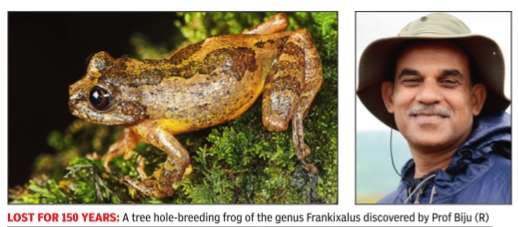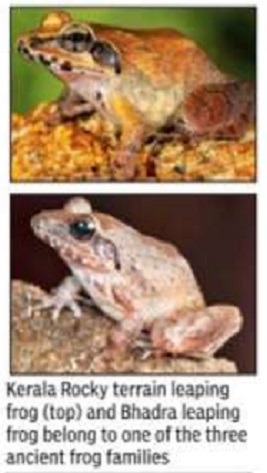Frogs: India
(→Night frogs, Bombay-) |
(→Western Ghats, February/ 2017: New night frog species found) |
||
| Line 68: | Line 68: | ||
The research team comprising scientists from University of Delhi, National Centre for Biological Sciences, Bengaluru, and University of Minnesota, USA, observed the frogs in the field for 40 nights during monsoon months between 2010 and 2012. Their findings were published in the journal `PeerJ' | The research team comprising scientists from University of Delhi, National Centre for Biological Sciences, Bengaluru, and University of Minnesota, USA, observed the frogs in the field for 40 nights during monsoon months between 2010 and 2012. Their findings were published in the journal `PeerJ' | ||
| − | |||
| − | |||
| − | |||
| − | |||
| − | |||
| − | |||
| − | |||
| − | |||
| − | |||
| − | |||
| − | |||
| − | |||
| − | |||
| − | |||
| − | |||
| − | |||
| − | |||
| − | |||
| − | |||
| − | |||
| − | |||
| − | |||
| − | |||
| − | |||
| − | |||
| − | |||
| − | |||
| − | |||
| − | |||
| − | |||
| − | |||
| − | |||
| − | |||
| − | |||
| − | |||
==The unique mating position of Bombay night frogs== | ==The unique mating position of Bombay night frogs== | ||
Revision as of 19:06, 15 April 2017
This is a collection of articles archived for the excellence of their content. |
Contents |
Leaping frogs: Indirana paramakri, Indirana bhadrai
Manash Gohain, Two new species croak at W Ghat, Nov 17 2016 : The Times of India
Two new species of frogs have been discovered by Professor Sathyabhama Das Biju, popularly called India's Frogman. This takes his count to 80 since his first discovery in 2003.The DU scientist's latest find took place in the Western Ghats in Karnataka and Kerala. The species from Kerala has been given the common name of Rocky terrain leaping frog (scientific name: Indirana paramakri), while the one in Karnataka is called Bhadra leaping frog (Indirana bhadrai).
This June, Biju's team chanced upon a strange mating process of the Bombay night frogs, while in 2014 he and his team had discovered seven species in the Western Ghats. In 2012, a team led by him had revealed to the world a new family of legless amphibians known as caecilians. Other successes of the Frogman have come in the forests of Nagaland.
The two frogs species belong to the Ranixalidae family, one of the three ancient frog families that diversified on the Indian landmass long before the extant frogs appeared in this region. “Nearly half of the currently recognised species in this family have been described only in the last three years,“ said Biju, adding that a new genus had been recognised to accommodate three previously known species.
Biju added, “Our surveys in the Western Ghats suggest the further presence of undescribed diversity in this group, thereby increasing all estimates of the family's diversity estimates.“
Biju and doctorate scholar Sonali Garg of the Department of Environmental Studies, DU, conducted extensive sampling of Indirana frogs from across the Western Ghats, and performed DNA barcoding for 200 ranixalid samples.
Nyctibatrachus (night frogs)
Manash Gohain, 4 miniature frogs that can sit on coin or thumbnail, Feb 23 2017: The Times of India
India now has the world's smallest known frogs.Seven such species were discovered by Professor S D Biju, known as the `Frogman of India' for his work on the amphibians, and his team from Delhi University in the Western Ghats. Of the newly discovered species, four are true miniatures with body lengths of 10-15 mm and can comfortably sit on a coin or a thumbnail.
These species belong to the genus Nyctibatrachus, commonly known as night frogs.Evolutionary biologist David Wake of the University of California, Berkeley, expressed surprise because the known nyctibatrachids are relatively larger.
Dr Ariadne Angulo, head of Amphibian Special Group at the International Union for Conservation of Nature, said the immediate priority for these newly described species, after being formally recognised as such, would be to assess their global extinction risk.
Unlike other frogs in the genus that are predominantly stream dwelling, the new miniature frogs were found among damp forest leaf litter or marsh vegetation. “The miniature species are locally abundant and fairly common but they have probably been overlooked all these years because of their extremely small size, secretive habitats and insect-like calls,“ said Sonali Garg, who undertook this study as part of her PhD research at DU.
This discovery of new species of ancient origin can provide useful insights into the evolution of endemic frog lineages in the Western Ghats, which is a global amphibian hotspot.
The past decade has witnessed a big increase in the number of new amphibian species found in this region. Of the 1,581 total new amphibians species reported across the world between 2006 and 2015, around 182 were from the Brazilian Atlantic forest, followed 159 in the Western Ghats-Sri Lanka biodiversity hotspot, with 103 species from the Western Ghats region alone.
Many of these new species are facing threats from human activity. Dr Angulo said that because several of the species have been identified as being range-restricted and impacted by threats, it was important to conduct their extinction assessments. “Once the extinction risk is assessed, both research and conservation actions can be tailored accordingly ,“ she said.
Night frogs, Bombay-
The Times of India, Jun 15 2016

Manash Gohain
Discovered: Konkan frog species' touchless sex
The female does much of the courting, the male is furiously possessive of her, but when it comes to intercourse, they make Victorian prudes seem rather forward.Meet the Bombay night frog, an oddity in the anuran world that reproduces without the mates touching each other. The complex world of frogs and toads comprising about 7,000 species has its own little Kama Sutra with six mating positions called amplexus modes (from the Latin word for `embrace') because the male clasps the female about the back during intercourse. But researchers led by Delhi University professor S D Bihu have found that the Bombay night frog adopts a seventh distinct position.
Called dorsal (back) straddle, it has the male spreading itself over the female's back with its feet clutching or resting over leaves and twigs on the sides. Bihu said the male appears to release sperm over the female's back and then moves away . After that, the female lays her eggs, which are fertilised by the sperm trickling down her back. In other frog species, females usually lay eggs during amplexus and males simultaneously release sperms to fertilise them.
“This is a frog with a re markable reproductive behaviour, and this discovery is fundamental to understanding the evolutionary ecology and behaviour in anuran amphibians,“ said Biju.
Bombay night frogs are found mainly near fast-flowing streams in the Western Ghats. They are classified as an ancient group of frogs that diversified 7080 million years ago. In the breeding season, they can be seen calling from the ground and over hanging vegetation in large numbers, soon after sunset.
The species also shows other rare sexual traits. For instance, the female, as also the male, croaks the mating call during breeding season, a behaviour seen in only 25 species worldwide. Fights between competing males are also common, and last until the intruder is thrown out.
The research team also observed eggs of Bombay night frog being eaten by snakes. It's the first documented observation of snakes eating frog eggs in India.
The research team comprising scientists from University of Delhi, National Centre for Biological Sciences, Bengaluru, and University of Minnesota, USA, observed the frogs in the field for 40 nights during monsoon months between 2010 and 2012. Their findings were published in the journal `PeerJ'
The unique mating position of Bombay night frogs
The frogs are secretive, breed only at night, and always at the peak of monsoon season, but researchers have finally identified their remarkable mating habits
They mostly come at night. Moments after sunset, and calling as they move, the Bombay night frogs climb high into the trees that overhang rivers swollen by the warm monsoon rains in the forests of Western Ghats in India.
And then the action begins. On rain-soaked leaves, branches and tree trunks, the amphibians pair up. The female sends a willing signal by backing towards her male and touching his head with her toes. What follows is a mating position never seen before in the wild world of frog sex.

Ian Sample, Science editor, The Guardian/ PeerJ
The Bombay Night frogs in Dorsal straddle: a new amplexus mode in frogs. Until Bombay night frogs fell under the spotlight, scientists had identified six mating positions among the world’s 6,650 frog species.
“It’s remarkable,” said Sathyabhama Das Biju, an expert on amphibians at the University of Delhi, who has published a comprehensive report on the frogs’ sexual antics. “So far, this mating position is known only in Bombay night frogs.”
It was 2002 when Biju first witnessed Bombay night frogs mating. But the animals are secretive, they breed only at night, and always at the peak of monsoon season. He got the odd glimpse, but not much else. It took eight more years for Biju to launch a study dedicated to unravelling the beasts’ mysterious breeding habits.
Now, after 40 nights in the forest, Biju has amassed enough field notes, photographs and infrared night-vision video footage from 13 encounters to describe the breeding habits of the frogs, Nyctibatrachus humayuni, in detail.
Until Bombay night frogs fell under the spotlight, scientists had identified six mating positions among the world’s 6,650 frog species. The male might clasp the female around the waist, grab her armpits, hold her head, attach himself to her back with a gluey substance, sit back-to-back, or perhaps sit on her head. But the Bombay frogs do none of these.
Before now, scientists had identified six mating positions among the world’s 6,650 frog species.
Writing in the journal PeerJ, Biju and his colleagues describe how they filmed males clambering on to females. What happened next was unexpected. Instead of clasping his partner, the male took hold of nearby branches or leaves to steady himself. He then appeared to release his semen on to the female’s’ back. Soon afterwards, the female shrugged the male off, and laid her eggs, which, the researchers hypothesise, are “fertilised by semen running down her back and hind legs.”
The researchers discover their remarkable findings.
Asked why the frog might have adopted the unusual approach to mating, Biju said: “We have no idea.” But the new position does have a name: the dorsal straddle. “It differs from the other six positions because the male does not grasp the female under her armpits or head, but instead places his hands on the leaf, branch or tree trunk the pair is sitting on,” he noted.
The 5cm-long Bombay night frog is endemic to the Western Ghats, a mountain range and world heritage site that runs parallel to the west coast of India, spanning a thousand miles from Gujarat to Kerala. While males of all frog species call for mates, Biju’s field recordings reveal that female Bombay night frogs issue their own calls, making them one of only 25 frog species known to do so. He also recorded fights among males, with interlopers forcefully barged out of the way, and predation of the frogs’ fertilised eggs, with 80% of a female’s clutch being eaten by nearby snakes.
Tree hole-breeding frogs
Frankixalus, a rhacophorid genus of
The Times of India, Jan 21 2016
Manash Gohain
New frog genus discovered in NE forests
Professor Sathyabhama Das Biju of DU, popularly known as the `frogman of India', and his team of researchers have discovered a new genus of tree holebreeding frogs in the forests of India's northeast and China. These frogs are special because the tadpoles feed on their mother's eggs.
The team comprised PhD students of Biju and researchers from National Centre for Cell Science (Pune), University of Peradeniya (Sri Lanka), Vrije Universiteit Brussel (Belgium) and American Museum of Natural History (USA).

The findings have been published in a paper titled Frankixalus, a new rhacophorid genus of tree hole-bre eding frog with oophagous tadpoles' in the current is sue of international journa PLoS One. The genus has be en named Frankixalus after Professor Franky Bossuyt of Vrije Universiteit Brusse for his contribution to amp hibian research.
“In 1870, British natura list T C Jerdon collected two specimens of a tree frog from forests of Darjeeling and preserved them at Natural History Museum, London. The frog was not found in the wild for over 150 years and was scientifically deemed lost. It remained a mysterious creature--a victim of mistaken identity ever since,“ Biju said.
The overlooked specimens in London were pulled out of the museum cabinets and studied, and the team conducted extensive field work for three years in the forests of Arunachal Pradesh, Manipur, Meghalaya, Naga land, Tripura, Sikkim and Darjeeling (West Bengal).The samples were analysed in the genetics lab of DU.
“Our discovery indicates that documentation of Indian amphibians is still incomplete. Unfortunately , many of them face various extinction threats, especially due to habitat loss and fragmentation. Several populations of the new genus were found in highly disturbed habitats, which is a reason for concern. Taking any conservation effort for amphibians will indirectly conserve several other life forms of that area,“ said Biju.
Biju and his team had in 2014 discovered seven new species of golden-backed frogs from the Western Ghats-Sri Lanka global biodiversity hotspot.
